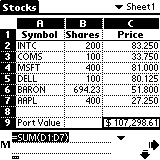 | |
| news | articles | reviews | software | modules | accessories | discussion | faq | mobile | store | |
| visorcentral >> reviews >> software >> quicksheet 5.0 | |
Quicksheet 5.0
Real-world test As part of my real world walk through, I'll first make a rough spreadsheet in Excel and port it over to Quicksheet. Tomorrow, I’m meeting with Color Lab to try to sort everything out; in my meeting, I plan to plug in all of the new information. If all goes well, I’ll have a coherent, up to date grasp of the finishing costs for the film. There is another competing lab, and I'll eventually plug in their numbers as well. Ultimately, I hope to use these numbers as a tool to negotiating the best deal. Morning errands
That Afternoon The next stop was at Color Lab, where I met with my contact Brooks. I had prepared three different worksheets in Excel. The top sheet deals with all of the costs of post production from here on out: music, titles, negative cutting. Then the second sheet looks at Colorlab’s blow up to 35mm. The final sheet examines the cost savings of ‘blowing down’ to 16mm, just in case your intrepid filmmaker runs out of cash. A quick technical note: shooting in super-16 (as opposed to regular 16) affords many advantages. You can still use 16mm cameras and film stock (cheaper than 35mm cameras and stock) but you use the entire frame of 16mm film. This adds to the quality of the picture significantly, since more surface area means better quality. Where does that extra room come from? In 16mm you leave room for the optical soundtrack to run up the edge. If you shoot in super-16 you loose the soundtrack space, which is why you have to either blow it up to 35mm (where there is plenty of room for the soundtrack) or blow down to regular 16 (to make room for the soundtrack).
One of the key things in film is footage count. Labs charge by the foot,
so a spreadsheet allows one to juggle the numbers based upon the length
of the film and easily adapt the numbers to another project. |
Update: Auction Update / VisorAdventure 2 Thu Oct 11 - 12:05 AM EST InnoGear PowerCradle (updated) Tue Oct 9 - 10:51 PM EST iambic Office suite Thu Oct 4 - 1:12 AM EST Prism dropped to $299 Tue Oct 2 - 6:19 PM EST New Portable Keyboard Tue Oct 2 - 4:46 PM EST |
| About VisorCentral : Copyright ©1999 Smartphone Experts All rights reserved : Terms of Use : Privacy policy |
 In
the morning, I went to visit my producer Michael Seabaugh over at Miramax.
We were zapping a tape over to the William Morris agency in the hopes of
finding completion funds. Michael asked me how much it would take to finish
the film. I had the numbers right in with and could give him a rough breakdown
without having to mess with files or information left elsewhere. I had
to scroll around hunting for the information, but the information was in
front of me in a few moments -- very handy. I felt that with a bit of practice,
that scrolling thing would be a bit easier.
In
the morning, I went to visit my producer Michael Seabaugh over at Miramax.
We were zapping a tape over to the William Morris agency in the hopes of
finding completion funds. Michael asked me how much it would take to finish
the film. I had the numbers right in with and could give him a rough breakdown
without having to mess with files or information left elsewhere. I had
to scroll around hunting for the information, but the information was in
front of me in a few moments -- very handy. I felt that with a bit of practice,
that scrolling thing would be a bit easier.
 What
was wonderful was that I had all of the numbers from
What
was wonderful was that I had all of the numbers from 
